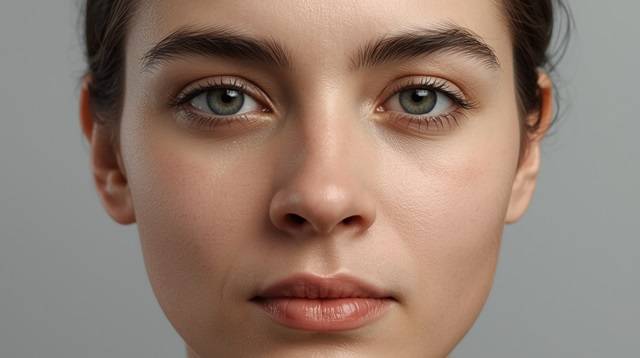When the Mirror Tells a Different Story
Imagine this: you saved diligently for your rhinoplasty, researched surgeons extensively, and went through the entire recovery period. Now, you’re looking in the mirror—and one nostril appears noticeably wider, or sits slightly lower, than the other. That’s the part most people don’t talk about during the initial consultation.
Asymmetry after rhinoplasty, particularly involving the nostrils, is more common than many patients realize. And while some minor imbalance might resolve as swelling subsides, persistent unevenness can affect both appearance and nasal function.
In this article, we’ll explore why nostrils can become uneven after rhinoplasty, what causes this asymmetry, the various solutions available, and—importantly—when asymmetry might actually be normal versus when it warrants concern.
Understanding Nostril Asymmetry: The Anatomy Behind the Issue
Before diving into causes and solutions, it helps to understand the nasal anatomy that creates nostril symmetry—or lack thereof. The nostrils, medically called nasal alae (plural of ala), are supported by cartilage and soft tissue. Their shape and position depend on several factors:
- The alar cartilage, which forms the nostril rim and tip support
- The nasal base, including the nostrils and the columella (the tissue between nostrils)
- Subtle variations in bone structure of the maxilla (upper jaw)
- Soft tissue characteristics that vary from person to person
Every nose has some inherent asymmetry—even before surgery. We tend to notice post-surgical asymmetry more because we’re paying closer attention to the results. Still, when asymmetry becomes pronounced after rhinoplasty, it usually relates to one of several issues we’ll discuss next.
Common Causes of Uneven Nostrils After Rhinoplasty
Healing and Swelling Variations
During the first few months after rhinoplasty, swelling can create the illusion of uneven nostrils. That’s completely normal. Swelling doesn’t always resolve symmetrically, and what looks concerning at three months often looks perfectly balanced by month six or twelve.
Many patients I’ve spoken with find this timeline frustrating because the final results aren’t visible immediately. The key is patience, combined with following your surgeon’s post-operative care instructions—including keeping your head elevated, avoiding strenuous activity, and attending all follow-up appointments.
Surgical Technique and Anatomical Changes
When the surgeon modifies the nasal structure, they’re working with delicate cartilage and bone. If cartilage wasn’t trimmed evenly, if grafts were placed asymmetrically, or if the nasal base wasn’t properly managed during surgery, you might end up with uneven nostrils.
Some techniques carry higher risks of asymmetry. Open rhinoplasty (where an incision is made across the columella) gives the surgeon more visibility, which can lead to better symmetry. Closed rhinoplasty (where incisions are inside the nose) is more challenging in terms of precise nostril management, though experienced surgeons achieve excellent results with either approach.
The surgical approach matters less than the surgeon’s skill in maintaining or creating symmetry during the procedure.
Pre-Existing Asymmetry
Here’s something important: if your nose was asymmetrical before surgery, simply straightening or reshaping doesn’t always fix all the nostril imbalance. A skilled surgeon will address this during the initial procedure, but sometimes pre-existing asymmetry becomes more noticeable after surgery—especially if it wasn’t fully addressed during the primary rhinoplasty.
That’s why detailed pre-operative photos and thorough consultations are so crucial. Good surgeons document asymmetry before surgery and explain what can realistically be improved.
Tissue Healing and Scarring
How your body heals plays a role, too. If one side develops more scar tissue than the other, or if healing occurs asymmetrically, it can affect nostril positioning. This is somewhat unpredictable, though certain patient factors (like smoking or poor wound care) can increase the risk of problematic scarring.
Signs It Might Be Time to Consider Revision
Not all asymmetry requires treatment. After rhinoplasty, minor differences between nostrils are often normal—especially in the early healing phase. When should you be concerned?
Watch for:
- Significant functional asymmetry (one nostril breathing is substantially worse)
- Nostrils that appear very different in size or shape beyond the first 6-12 months
- Asymmetry combined with breathing difficulties
- Visible cartilage irregularities or deformities
Normal variations might include:
- Slight size differences that you notice but others don’t immediately see
- Subtle positioning differences that don’t affect breathing
- Asymmetry that’s actually less pronounced than before your primary rhinoplasty
From a patient’s perspective, the question isn’t just “are my nostrils identical?” but rather “do they look natural and balanced, and do I breathe well?” Perfect symmetry isn’t the goal—natural, harmonious appearance is.
Treatment Options: From Non-Surgical to Revision Surgery
Non-Surgical Approaches
For mild asymmetry, non-surgical interventions might be sufficient. Injectable fillers can help balance subtle differences, though this is temporary (typically lasting 6-12 months). Strategic filler placement can camouflage minor asymmetries without the downtime or expense of surgery.
However, this approach is limited. If the asymmetry is due to cartilage misalignment or structural issues, fillers can’t address the underlying problem—they can only mask it temporarily.
Revision Rhinoplasty (Secondary Rhinoplasty)
When asymmetry is significant, persistent beyond the healing period, or affects breathing, revision surgery becomes the most reliable solution. Revision rhinoplasty is generally more complex than primary rhinoplasty because the surgeon is working with altered anatomy, existing scar tissue, and often more conservative cartilage reserves.
What to expect in revision surgery:
The surgeon will assess the asymmetry’s root cause and develop a targeted approach. This might involve:
- Adjusting alar cartilage to reposition nostrils
- Placing grafts to support and balance the nasal base
- Correcting the columella position if it’s contributing to the asymmetry
- Addressing any breathing issues simultaneously
Recovery time is similar to primary rhinoplasty—about 1-2 weeks before returning to light activities, with full healing taking 12-18 months.
Choosing the right surgeon is critical.
Not all surgeons perform revision rhinoplasty regularly, and it requires specialized expertise. Look for a surgeon who:
- Has extensive experience specifically with revision rhinoplasty
- Shows numerous before-and-after photos of revision cases
- Listens carefully to your concerns and sets realistic expectations
- Can explain the technical approach they’ll use for your specific asymmetry
Prevention and Realistic Expectations
Can uneven nostrils be prevented? To some extent, yes. Careful patient selection, detailed pre-operative planning, and choosing an experienced surgeon all reduce the risk.
But complete prevention isn’t possible. Some asymmetry might stem from how your unique anatomy heals, or from pre-existing asymmetry that couldn’t be fully corrected in one procedure.
Setting realistic expectations matters. Discuss symmetry concerns with your surgeon before the initial procedure—don’t assume they’ll notice and address everything automatically. The best patient-surgeon relationships involve open dialogue about what can and can’t be achieved.
Moving Forward: What to Ask Your Surgeon
If you’re concerned about uneven nostrils after rhinoplasty, here’s what to ask during a follow-up or consultation:
- Is this asymmetry within normal variation, or does it warrant correction? (Don’t skip this—many patients worry about minor differences that are actually normal)
- If revision is recommended, what’s driving the recommendation—aesthetic concerns, functional issues, or both?
- What’s the proposed approach, and what are the realistic outcomes I can expect?
- Are there any non-surgical options worth trying first, or is revision surgery the best path forward?
- Timeline: When would revision ideally be performed? (Most surgeons recommend waiting at least 12 months after primary rhinoplasty to allow complete healing and swelling resolution)
The Human Side of Rhinoplasty Results
Here’s what most surgeons don’t say enough: some degree of nostril asymmetry is normal, in natural noses and post-surgical noses alike. The goal of rhinoplasty isn’t creating perfect symmetry—it’s creating a nose that looks natural, functions well, and improves your overall facial harmony.
That said, if your nostrils are genuinely uneven in a way that bothers you, or if breathing is affected, you absolutely deserve answers and solutions.
Many surgeons I’ve spoken with emphasize the same point: revision surgery isn’t a failure—it’s a tool for refinement. When performed thoughtfully by a skilled surgeon, revision rhinoplasty can successfully address asymmetry and achieve the results you were hoping for initially.
Conclusion
Uneven nostrils after rhinoplasty can stem from swelling during healing, surgical technique variations, pre-existing asymmetry, or healing differences. While complete symmetry isn’t realistic or necessary, significant asymmetry that persists beyond the healing phase—or that affects breathing—may warrant correction through revision surgery.
The journey doesn’t have to end with your primary rhinoplasty results. With careful evaluation, realistic expectations, and an experienced surgeon, revision rhinoplasty can refine your nose’s appearance and function to better match your goals. The key is giving your nose time to heal, then having an honest conversation with your surgeon about what you’re seeing versus what’s actually concerning.
If you’re experiencing nostril asymmetry after rhinoplasty, don’t navigate this alone. Schedule a consultation with your surgeon or seek a second opinion from a revision rhinoplasty specialist to discuss your specific situation and available options.

